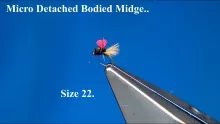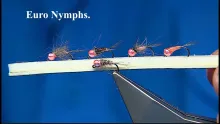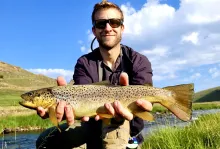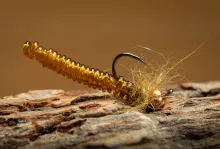Ok - this sounds cliché - but it is the absolute truth: but it is the absolute truth: If you flyfish for trout - this book is a must read.
Updated or edited 9 months ago
Ok - this sounds cliché - but it is the absolute truth: but it is the absolute truth: If you flyfish for trout - this book is a must read. With clear photography, concise writing, and excellent layout, Ed Engle has come out with a real winner - one of the best of the new millennium.
While it may have started as a compilation of previously published magazine articles, it does not have any of the start-and-stop feel of an anthology, where one might glance up from his reading and wonder "where did *that* come from?!?". Each of Ed's chapters has the same tone and the same feel, making for easy and enjoyable reading. Simply put, the book reads as if Ed sat down, started typing, and didn't get up until the final page was complete.
Inside the cover are Ed's decades of experience with small flies, with plenty of anecdotes about "the old days" when he first starting tying and fishing them, as well as up-to-the-minute information about the latest in materials, patterns, and techniques. He manages to span the entire subject matter without once losing his sense of audience. You won't find instructions on how to do a whip finish in this book. Ed expects you to know how to tie flies. This frees him up to deal with subjects that are only germane to *small* flies.
The book starts off with a history of small flies. As you may guess, small flies require small hooks to tie with, and thin supple leaders to fish with. While these items are commonplace in today's fly shop, it was not always so. I was surprised to learn of anglers fishing tiny flies at the dawn of the 20th century using a single horse hair leader. Can you imagine? It makes me feel a little silly complaining about 7x tippet that tests out at about a pound and a half breaking strength, fished with a limber 2 ounce graphite rod with a reel whose drag is as smooth as my little girl's cheek. Now think about tying flies on one of those antique tiny hooks without the aid of your midge jaws and 14/0 thread. Yeah - we've got it easy.
The book continues on to deal with the two most important aspects of small fly tying - the hooks and the threads. While it is technically possible to tie small patterns on larger hooks, such as the low water salmon flies, if you are intending to tie a proportionally correct representation of a tiny insect, and expect it to float, you really need a similarly tiny hook. In order to be able to bind down the materials, your must be able to make sufficient wraps of thread without creating excessive bulk. Ed deals with both of these subjects in great detail - while avoiding unnecessary jargon. He's not one for testing the breaking strength of threads, or getting out the micrometer to measure wire thickness. He talks to us in plain English, discussing hooks and threads in the context that is important to him and to us - fly tying and fishing.
The rest of the book broken up into chapters dealing with either certain tying issues (such as making tiny flies sink, adding flash, etc.), specific insect types (olives, microcaddis, midges, etc.), or generic pattern styles (parachutes, floating nymphs, etc.). What I found most interesting is how he kicks off each chapter, even the individual sections within a chapter, with a bit of problem solving. He'll talk about his fishing, and how the flies that are he is about to present are used to solve certain fishing problems - the front end of an olive hatch, for example, or the dreaded trico hatch. You're gonna learn a heck of a lot more than how to tie small flies when you read this book.
Ed chooses to close the book with a discussion of 32's - the Holy Grail of small flies. After all, if we're talking about big fish, we want to talk about the biggest fish. If we talk about fast cars, we talk about the fastest cars. Thus, with small flies - we are naturally curious about the smallest flies! These are the 32's of course. Thankfully, Ed doesn't waste our time with parlor tricks or gimmicks. Rather, he makes an earnest attempt at tying a fishing fly on the smallest hook of them all. It may not be my cup of tea, but some might consider the book incomplete unless he took us all the way.
Geez, it seems like I could write about Ed's book forever. Truly influential books are few and far between. I cannot help but believe this is one of the rare exceptional books that will inspire people and make a difference where it matters most - in their fly boxes and on the stream.
Congratulations, Ed. Job well done.
- Log in to post comments








which Ed ENgle is th
which Ed ENgle is this.. how old is he?